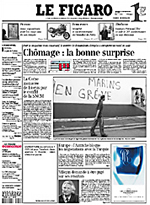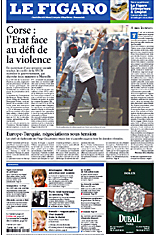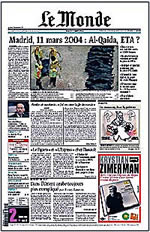
| Fit To Print |
 |
followthemedia.com - a knowledge base for media professionals |
|
|
AGENDA
|
||
Le Figaro Relaunches and Claims to Finally Stop The French National Newspaper Circulation Rot with a 16% Increase; That Has Everyone Holding Their Breath for the Le Monde Relaunch in NovemberRelatively speaking it has been a good year for Le Figaro. Its circulation has declined only by 2.4% to 326,290 from a year earlier while Le Monde’s circulation dropped 3.9% to 324,401. Because Le Figaro’s decline was less than Le Monde it finally overtook Le Monde, making France’s oldest newspaper also its leading circulation national daily newspaper. A somewhat hollow victory!
|
| ftm background |
|
Despite a Near Unanimous Traditional Media Urging Oui, the French Voted A Big Non to the European Constitution Proving Print and Broadcast Are Not As Powerful As They Think They Are. Or, Put Another Way – The Internet Rules the Information Age French, Spanish and Italian Financial Backers Provide Le Monde With Much Needed Financial Support Keep an Eye on Lagardère: Media Revenues Up 8%, Dumps Most of Its T-Online Stake, Readies Investment in Le Monde and Canal Plus, and Has Eyes Set Firmly on US Expansion The Very Rich (Bankers and Industrialists) Come to the Aid of the Very Poor (French National Newspapers). But Is It In Time? |
So that has everyone waiting for Le Monde’s relaunch, due November 7. Given that Le Monde has long been France’s leading newspaper, considered to be within the world’s top five most prestigious newspapers, it is of more than a passing interest that it gave the relaunch to the dreaded Anglo-Saxons – Palmer & Watson based in Scotland.
One reason for Le Figaro’s circulation slide over the past years is that its readership has grown progressively older. The average reader age before the relaunch was 55-57. The paper is now aimed at those in their 40s, executives, and particularly women who in France are not great newspaper readers.
Although the same length, the paper is narrowed by 3.4 cm (1 1/3 inches) so that its width is about the same as an American broadsheet, but it is about 5 cm (2 inches) shorter.
It is divided into three sections – home and foreign news including sports, the pink colored business section, and a new section called “and you” focusing on lifestyle – fashion, culture, leisure and travel The cover price remains €1.
Signifying its pro-Europe stance it now carries a white title coming out of a blue masthead (the EU blue color). The overall intent is to make the paper look brighter.
Pictures and graphics now get more space, as does sports, medicine and science.
In many ways it is the same type of relaunch that Britain’s Guardian underwent last month. It, too, had circulation just about the same as Le Figaro and after the relaunch it, too, is enjoying circulation around 400,000.
Le Figaro’s relaunch, and the upcoming Le Monde relaunch, do not hide another hideous circulation year for the French nationals, but new ownership has at least allowed both to reinvest for the future.



Serge Dassault, who runs France’s most important defense industry of the same name, last year bought around 80% of Socpresse, which owns Le Figaro among other notable titles, for €1.5 billion. He has let it be known he doesn’t appreciate articles that are not business friendly – causing more than 10% of the Le Figaro journalists to leave -- but he has opened his wallet for the badly needed reinvestment not only for the newspaper’s re-design but also for a new printing plant in southern France.
Le Monde raised €65 million via three additional investors -- Lagardere, the French media and industrial conglomerate, Spain’s Grupo Prisa, which publishes Madrid’s prestigious El Pais newspaper and Italy’s La Stampa owned by the Agnelli family. .
Le Monde needed the increased capital to handle debts of more than €100 million, and losses in the past two years of €77 million, including €50 million last year alone.
Le Monde was hit hard because of new free tabloids, free news on the Internet, a soft advertising climate, and uniquely because of some riveting scandal published in a best selling book describing how the newspaper was run. That all resulted in a 6% circulation decline in 2004, continuing into this year.
But a third important investment, by Edouard de Rothschild, scion of the banking family, who paid €20 million for a 37% stake in very left Liberation, does not yet appear to be bearing new fruit. The latest circulation figures show Liberation down a full 9.8% over the previous year and the stage is being set for a major industrial conflict as job cuts are seriously considered.
Liberation has its roots going back to the 1968 Paris student riots. It was founded by Serge July, then a Maoist student leader who today still heads the newspaper, and by radical left-wing philosopher Jean-Paul Satre. De Rothschild has 37% of the voting rights and does not interfere in editorial policy. But with circulation down to 134,600 even though DeRothschild has deep pockets it is obvious something needs to be done quickly to stop the red ink. .
France suffers from a very antiquated slow national newspaper distribution system making early afternoon deadlines necessary for distribution outside Paris. Local and regional newspapers can easily print later news and have therefore stolen many readers from the nationals. It is one reason why national newspapers have only around 20% of the nation’s readership whereas regional newspapers have about 60%.
What is difficult to understand in the French culture is that newspaper readership ranks very low when compared to other European countries. Could it be the French don’t trust their newspapers? The French are certainly avid readers willing to spend their money on publications – they are among the world’s largest per capita readers of magazines with their circulation far exceeding newspapers.
Why read magazines over newspapers? So, how do you turn Paris Match into a daily?
One of the great tragedies of French media is how the mighty France-Soir with a circulation of more than one million during the 1960s to outdo all others, fell into bankruptcy in 2005 with circulation of only around 50,000, and now its new owners plan to slash staff by 55% to stop the €800,000 a month red ink.
Staff, understandably, aren’t happy with those plans, so they walked out last week and printed their own special edition with that most patriotic of French words – “Resistance” -- plastered across the front page. France-Soir started life during World Wart II as part of the French underground resistance to German occupation.
Staff say they are appealing the decision by a Tribunal of Commerce to accept the bid led by French real-estate developer Jean-Pierre Brunois.
The tribunal had a choice of handing the paper over to Brunois, with his business plan of turning France-Soir into a rag with heavy emphasis on sport, horse racing, and celebrity news, but also dumping more than half the staff, or letting a Russian publisher, Arkadi Gaydamak, take over with his promise not to fire any staff.
Oh, almost forgot, Gaydamak had to make his bid by proxy -- he can’t set foot in France for fear of arrest in connection with charges of tax evasion and illegal arms dealing with Angola. The Israelis also want the Russian, who is publisher of the Moscow News Company, for money laundering.
While all French national newspapers have suffered at the hands of the Internet and free newspapers, France-Soir suffered most of all. Its previous owner who led it into bankruptcy was Egyptian businessman Rami Lakah, who had left Egypt under some financial clouds.
This once-proud newspaper deserved better than all this.
Libération staff went on strike for four days this week to protest a plan to lay off 52 employees. The newspaper said the strike cost it nearly €500,000.
The paper has reported only bad news about itself this year since Edouard de Rothschild invested €20 million for a 39% stake. Circulation is down nearly 10% to 135,000, advertising is down 10% and the paper is losing around €500,000 a month.
And in other French media news, Bertrand Eveno, ceo of Agence France Presse (AFP) has resigned for what he said in a note to staff were “personal reasons.”
His contract currently runs through October, 2006, but he has said that is too close to the French Presidential elections in 2007 for a new ceo to be appointed.
And should you be asking yourself what a Presidential election has to do with the appointment of a ceo to an independent news agency then keep in mind that AFP loses money each year - but not as much as it used to - and those losses have to be made up by someone, and that more than 40% of its revenue comes from subscriptions by various French government entities.
Eveno said he decided to resign several weeks before a recent 85% no confidence vote by staff complaining that management agreed to a police request earlier this month to hand over pictures taken of protesters beating a police officer in Marseilles.
| copyright ©2005 ftm publishing, unless otherwise noted | Contact Us • Sponsor ftm |